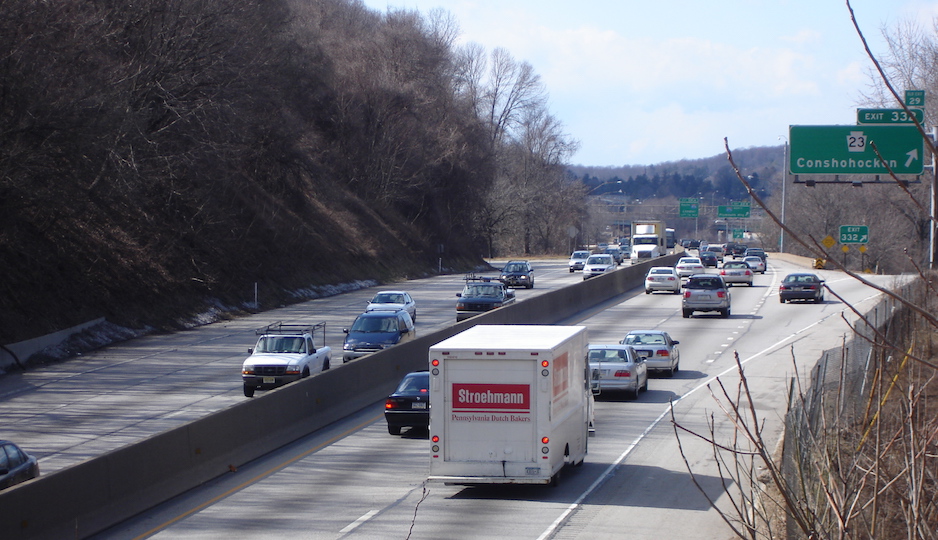We Won’t Be Driving on the Shoulders of the Schuylkill Expressway Anytime Soon

The Schuylkill Expressway westbound at the Conshohocken exit. A proposal to allow driving on the shoulder at peak hours may run into a few roadblocks. Photo | Krimpet. Licensed under CC BY-SA 3.0.
The news earlier this month that PennDOT is considering opening the shoulders of the Schuylkill Expressway to general traffic at peak hours caused a stir in some circles, including ours.
There are indeed a number of people out there, including planners at PennDOT, who see this as a way to speed up traffic on the perennially clogged artery.
But before anyone can even think of traveling in these temporary third lanes, PennDOT has some engineering and design issues it needs to examine first. And PennDOT’s study doesn’t even attempt to answer the question: Is this wise policy to begin with?
Before getting to that question, though, let’s look at the other issues that need to be resolved first.
One is that of space. If the space that’s ordinarily used to get breakdowns out of the way is used by drivers instead, substitute space will have to be provided for breakdowns. That might be difficult on the Schuylkill, given its location between the side of a hill and a steep drop-off to the river floodplain below.
Some of the overpasses also have abutments that are close to the travel lanes, and something would have to be done in order to allow cars to pass under them in a third lane.
In addition, said PennDOT District 6 spokesperson Gene Blaum, “the shoulders aren’t of a uniform width along I-76.” Can they be easily widened where they’re too narrow for safe travel? That’s a question PennDOT’s study seeks to answer. In fact, Blaum said, “those things are all part of this study: areas where you provide space for breakdowns, looking at the width of the existing shoulders, the location of abutments on bridges, the width of the shoulders on the existing bridges, those are the things we’re looking at in this study.”
And they’re also looking at transportation alternatives in the corridor, such as variable message signs directing motorists off the expressway and onto SEPTA Regional Rail at Conshohocken if traffic’s really heavy.
And again, like all those other issues of physical space, this alternative isn’t quite at the point where it could handle the added traffic, but SEPTA is working on that. Agency spokesman Andrew Busch said SEPTA has been in talks with both Conshohocken Borough and Montgomery County about putting in transit-oriented development at the Conshohocken station that would also include additional commuter parking. “We’re looking to partner with a private developer that would build a parking structure along with other development on top of or beside it,” he said.
SEPTA also has $15 million budgeted in its “Rebuilding for the Future” capital program for improvements to the station itself, including accessibility improvements; work on this is scheduled to begin with the design phase next winter and wrap up with the opening in the winter of 2020. By then, the new locomotive-hauled double-deck Regional Rail cars should be in service to add capacity to the currently crowded Manayunk/Norristown Line as well.
At least SEPTA’s plans avoid having to ask the question, “But do we really want to encourage more people to drive into the city?”
Studies of what’s known as “hard shoulder running” in Europe have so far concluded that opening the shoulder to general traffic does ease congestion and makes roads no less safe than they are now. But most agencies that implement such a policy combine it with more active monitoring of the road and more roadside technology like variable message signs, traffic cameras, and guide arrows.
A few freeways in the United States, including I-66 in Virginia, I-93 in Boston and I-35W in Minneapolis, allow travel in the right shoulder lane during peak hours (after paying a toll in Minneapolis), with no adverse impact on road safety. (The U.S. Federal Highway Administration has a good summary of a number of hard shoulder running projects here.) If all opening the shoulder on the Schuylkill does is give the existing traffic more room to maneuver, then it might be worth considering, but around these parts at least, every time a highway is expanded, cars rush in to fill the new space. And there are no plans to make the streets of Center City wider: on the contrary, city transportation officials are committed to making them more accommodating of bicycles and pedestrians while reducing fatalities and accidents.
Maybe instead of opening the shoulders to more cars, we should consider turning them into express bus lanes at peak hours instead. Residents and workers in both Center City and King of Prussia might appreciate that.
Follow Sandy Smith on Twitter.


